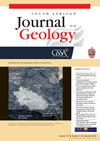罗迪尼亚断裂的运动学和时间:刚果克拉通西南角(纳米比亚西北部)一个可能的深冷期裂谷转换接合点
IF 1.2
4区 地球科学
Q2 GEOLOGY
引用次数: 5
摘要
纳米比亚西北部原刚果克拉通西南角的一对深冷系半地堑经过埃迪卡拉纪厚皮褶皱的倾斜校正后,恢复了不同的走向。Toekoms子盆地走向东北偏东,平行于达马拉带北段(NZ),以一条向CC倾斜57°的正常生长断裂(2 290 m)为界,Soutput子盆地走向西北,向NZ倾斜,向北西北走向Kaoko带倾斜。它的边界是一条向CC方向倾斜(~75°)的生长断层(下倾750 m),其输出生长断层可能是一条连接新西兰低温系裂谷带和Kaoko带左旋转换带的斜(展)断层。与岩浆丰富的南缘不同,考科边缘的转换成因与缺乏岩浆的陆棚-盆地突变相一致,表明其机械强度较弱。裂谷-转换结与观测到的川中盆地内北-西北-南-东南的低温期地壳伸展在运动学上是一致的。川中盆地碳酸盐岩台地的裂谷后沉降在南向的陆架上变化强烈,而在西向的陆架上则没有变化。剪断的西CC边缘与现有的考科带模式不同,考科带模式假定与超伸展的大陆地壳呈正交开口。西南碳酸盐岩为主的沉积意味着770 ~ 600 Ma之间的古纬度≤35°。本文章由计算机程序翻译,如有差异,请以英文原文为准。
On the kinematics and timing of Rodinia breakup: a possible rift–transform junction of Cryogenian age at the southwest cape of Congo Craton (northwest Namibia)
After tilt correction for Ediacaran thick-skinned folding, a pair of Cryogenian half grabens at the autochthonous southwest cape of Congo Craton (CC) in northwest Namibia restore to different orientations. Toekoms sub-basin trended east-northeast, parallel to Northern Zone (NZ) of Damara belt, and was bounded by a normal-sense growth fault (2 290 m throw) dipping 57° toward CC. Soutput sub-basin trended northwest, oblique to NZ and to north-northwest-trending Kaoko Belt. It was bounded by a growth fault (750 m down-dip throw) dipping steeply (~75°) toward CC. Soutput growth fault could be an oblique (splay) fault connecting a Cryogenian rift zone in NZ with a sinistral transform zone in Kaoko Belt. A transform origin for the Kaoko margin accords with its magma-poor abrupt shelf-to-basin change implying mechanical strength, unlike the magma-rich southern margin where a gradual shelf-to-basin change implies a mechanically weak extended margin. A rift−transform junction is kinematically compatible with observed north-northwest−south-southeast Cryogenian crustal stretching within CC. Post-rift subsidence of the CC carbonate platform varies strongly across the south-facing but not the west-facing shelf. A sheared western CC margin differs from existing Kaoko Belt models that posit orthogonal opening with hyper-extended continental crust. Carbonate-dominated sedimentation over southwest CC implies palaeolatitudes ≤35° between 770 and 600 Ma.
求助全文
通过发布文献求助,成功后即可免费获取论文全文。
去求助
来源期刊
CiteScore
3.60
自引率
5.60%
发文量
18
审稿时长
>12 weeks
期刊介绍:
The South African Journal of Geology publishes scientific papers, notes, stratigraphic descriptions and discussions in the broadly defined fields of geoscience that are related directly or indirectly to the geology of Africa. Contributions relevant to former supercontinental entities such as Gondwana and Rodinia are also welcome as are topical studies on any geoscience-related discipline. Review papers are welcome as long as they represent original, new syntheses. Special issues are also encouraged but terms for these must be negotiated with the Editors.

 求助内容:
求助内容: 应助结果提醒方式:
应助结果提醒方式:


